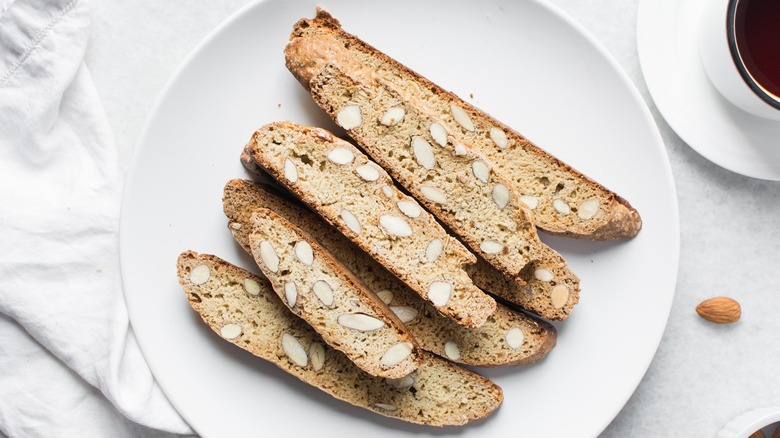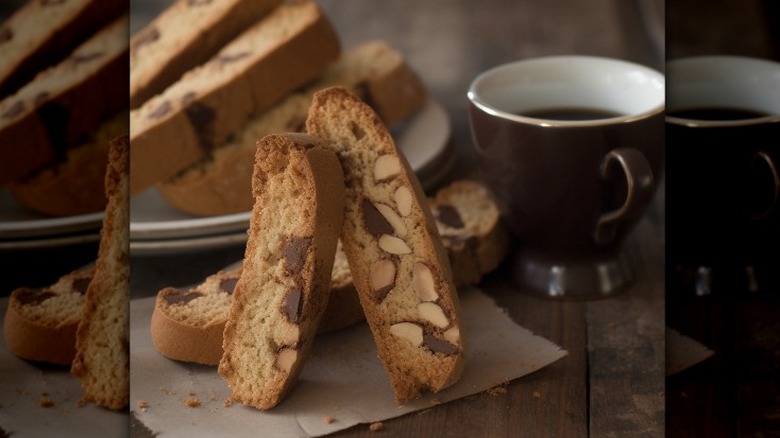The Storied History Of Biscotti Cookies
The crunchy biscotti cookies we know and love today have developed across numerous cultures and eras: To start, Roman soldiers ate hard buccellatum soused in vinegar; Venetians like Marco Polo (who did not invent spaghetti, by the way) and Christopher Columbus were said to travel with biscotti, likely soaking theirs in wine; during the American Civil War, soldiers dipped their hardtack in coffee; those serving in the U.K.'s Royal Navy dunked their hardtack in stew or tea; Jewish bakers made Yiddish Mandelbrot or Ukranian kamishbrot (subbing Matzoh meal for flour during Passover), which was commonly dipped in sweet tea. But our modern understanding of biscotti as a sweet, flat cookie can be traced to Florence, Italy in the mid-1880s.
In 1858, Antonio Mattei created a sliced almond cookie in his Via Ricasoli bakery. Cantucci di Prato were baked twice and had an especially long shelf life — a practical food for soldiers, sailors, or anyone on a journey. The cookies were paired with Vin Santo, though today, most Americans pair them with coffee. In the U.S., DiCamillo's Biscotti were made by Italian immigrants in Niagara Falls. In 1979, the DiCamillo family debuted a version called biscotti di vino that was made with red wine and rolled in sesame seeds, and it became popular throughout the 1980s in department stores across NYC, Chicago, and Toronto. Biscotti are traditionally made without butter or oil, so they boomed in the U.S. during the '80s and '90s when low-fat diets were in vogue.
Biscotti's U.S. popularity rose alongside that of coffeehouses
Biscotti's U.S. rise can no doubt be partially attributed to the fact that the cookies pair well with espresso or coffee. A shelf-stable cookie soon proved to be popular within the burgeoning Starbucks empire and the independent coffee shops that blossomed around it. There were just 200 coffee houses in the U.S. in 1990, and by 2003, there were 14,000 — with about 30% belonging to Starbucks, according to the Journal of Consumer Research. Even now, individually packaged vanilla biscotti are a familiar sight at the Starbucks register.
As with Italy's cheeses (just check out our expert-curated guide), Italy's biscotti additions are specific to each region: Almonds grow prolifically near Prato; anise grows near Calabria; citrus peels like lemons originate near the Amalfi Coast; and hazelnuts and olive oil appear near Viterbo, where they're known specifically as tozzetti. "Biscotti," a 2010 cookbook by Mona Talbott (of Chez Panisse) and Mirella Misenti, divides the cookie's traditional flavors into milk and wine; honey, citrus, and spice; nuts; meringue; and chocolate. The cookies require no special equipment other than a serrated knife, nor do they require certain weather conditions for a good rise, though some variations may include baking soda, baker's ammonia (a smart swap for baking soda to make crunchier biscotti), or self-rising flour. Try our delightful homemade biscotti recipe — it contains butter, thus yielding a slightly softer cookie.
Static Media owns and operates Mashed and Tasting Table.

